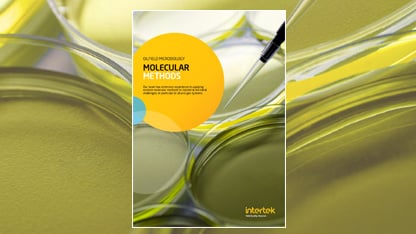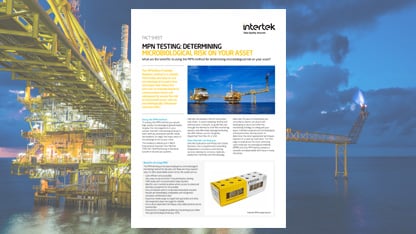Microbiological testing can help to identify potential energy infrastructure problems and allow for better-informed materials selection.
Microorganisms threaten industrial operations through microbiologically influenced corrosion, water quality deterioration and biomass blockages, and more specifically for oilfield operations reservoir souring. Failure to conduct microbiological testing and leaving microbial activity unchecked can present a wide range of problems for organisations.
From our microbiology centres of excellence, we can offer your organisation reliable and effective microbial testing services and our qualified technicians can conduct on-site sampling for platforms, drilling rigs, storage terminals, refineries and vessels, or samples can be sent to our dedicated laboratories.
Sample testing is one of our specialist capabilities and our range of methods can improve detection of planktonic microbes including extremophilic bacteria and archaea, fungi, yeast and moulds. Moreover, dedicated procedures can enhance detection of sessile populations from a range of media such as coupons, swabs, waxes, solids, and biofilms. Samples can be taken from systems for water injection, production, processing, utilities, cooling and heating systems, fuel distribution, or any other area suspected of contamination issues.
Robust and cost-effective culture-dependent testing methods provide valid and informative testing and quantification of viable microorganisms. For enhanced detection rates, molecular microbiological methods (MMM) and techniques should also be adopted which can provide thorough results with faster turnaround times. Below is a list of the complementary methods we offer.
The most probable number method using microbiological growth media detects and quantifies the microorganisms responsible for microbiologically influenced corrosion and other problematic microbial populations. This is the only test method that estimates viable cell counts of specific populations based on actual microorganism growth and activity. General fouling can be estimated using culture media for both aerobic and anaerobic bacteria, or niche bacteria such as sulphate-reducers, nitrate-reducers, iron-oxidisers, and oil-degraders, among many others, can be tested using specially formulated recipes. Culture media can be made to any salinity level you require so that testing can be performed on any system. This can be freshwater for potable supplies, seawater, or produced water and brine from high salinity oilfields.
Our high-quality media test kits can be easily ordered and distributed globally, see our page on microbiology media test kit solutions for further information.
For regular testing of biological load in your system ATP testing can be performed. Once a reliable baseline has been established, regular (daily or weekly) testing can help indicate overall microbial load and may be used to assess treatment efficacy. However, this technique cannot be used to identify microbial corrosion risk or onset of reservoir souring, among other problems related to specific populations such as sulphate-reducing prokaryotes. This is because ATP is found in all living cell forms (bacteria, fungi, plants, animals etc) and offers no assessment of niche organisms. Therefore, we always recommend using ATP in conjunction with techniques that capture target microorganisms of interest, such as MPN or qPCR, for optimum risk management strategies.
This is a DNA-based approach to quantify specific microorganisms that can specifically increase a target (gene) from an undetectable amount of starting material. During qPCR, gene copies are made during thermocycling, and a fluorescent marker accumulates, which can be used to quantify the starting number of the target gene.
Advantages include targeting specific genes, higher sensitivity and yielding faster results than MPN counts. This allows targeting of problematic organisms related to MIC, such as sulphate-reducing bacteria (SRB), sulphate-reducing archaea (SRA), acid-producing bacteria (APB) and methanogens (Meth) among many others. Contact us for full list of available qPCR assays and sampling procedures.
NGS allows DNA metagenomic sequencing of a sample to establish the microbial composition. Of the various NGS platforms, we favour Illumina pyrosequencing which can read up to 20 million bases per run and give a deep insight into microbial communities in certain samples. Its primary advantage is enabling the identification of microorganisms present in samples down to the genus level for a more detailed assessment of the microbial communities, particularly useful for understanding community shifts in response to environment changes. It can also be used to make comparisons between different samples, or sources, as a baseline and trend changes over time. It is particularly informative in MIC failure investigations as it can give an indication of predominant microbes and their relative abundance.
Decades of Total Quality Assurance experience and lasting partnerships with both national and international energy organisations have enabled us to build a reputation for delivering reliable, high-quality testing solutions. In addition to sample testing, we also offer a wide range of bespoke testing solutions as part of your research project requirements.
Our global reach ensures that you can access vital services whenever and wherever you need them the most. Providing testing and analysis, and a comprehensive range of related services for over three decades, we can offer world-class knowledge supported by innovative in-house research and development. Contact us to explore how we support your microbiological testing needs.


